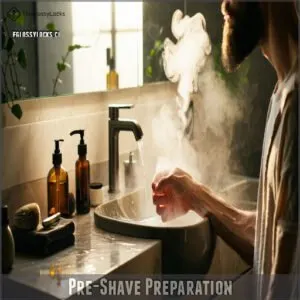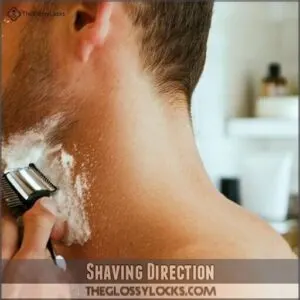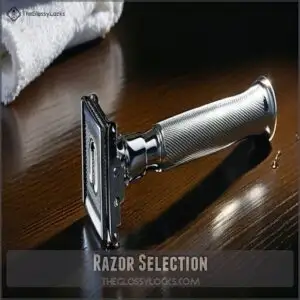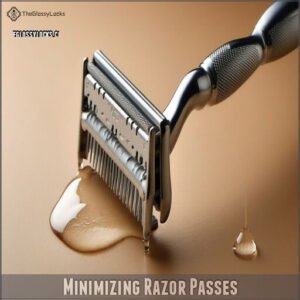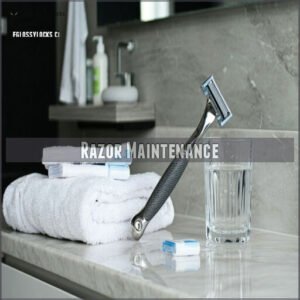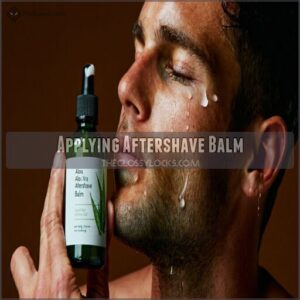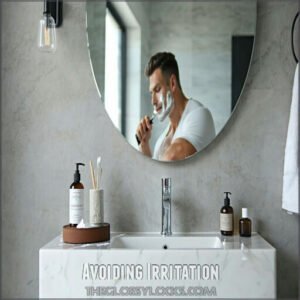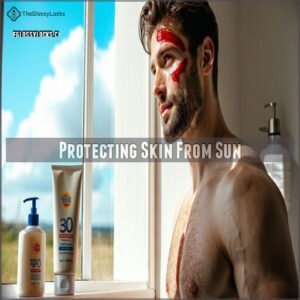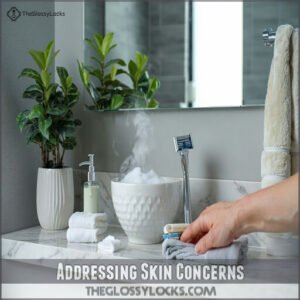This site is supported by our readers. We may earn a commission, at no cost to you, if you purchase through links.

Choose the right razor and shave with the grain, using a gentle touch. Don’t forget to rinse often and apply shaving cream for a closer shave.
With the right techniques and tools, you’ll be on your way to a silky finish – and we’re just getting started on the secrets to a perfect shave.
Table Of Contents
- Key Takeaways
- Pre Shave Preparation
- Shaving Techniques
- Razor Maintenance
- Post Shave Care
- Addressing Skin Concerns
- Frequently Asked Questions (FAQs)
- How to get a perfectly smooth shave?
- How do you shave down there super smooth?
- Why am I not smooth after shaving?
- How to get no stubble after shaving?
- Can shaving affect skin elasticity?
- How often exfoliate before shaving legs?
- Does shaving remove skin tags?
- Can shaving cause skin discoloration?
- Is shaving bad for acne scars?
- Conclusion
Key Takeaways
- You’ll get a smooth finish by prepping your skin with warm water and a quality pre-shave oil, and then shaving with the grain using a gentle touch.
- To minimize razor burn and ingrown hairs, you should exfoliate your skin 2-3 times a week, use sharp razors, and apply aftershave balm and moisturizer after shaving.
- You can reduce irritation and achieve a closer shave by using the right tools, such as a sharp razor and quality shaving cream, and by shaving in the direction of hair growth.
- To maintain healthy and smooth skin, you should store your razor properly, replace blades regularly, and practice good hygiene, and consider seeking professional help if you have persistent skin concerns or questions about proper shaving techniques.
Pre Shave Preparation
You’re about to learn the secrets to a smooth shave, and it all starts with pre-shave preparation.
By exfoliating your skin, identifying your skin type, and choosing the right tools, you’ll be setting yourself up for a comfortable and effective shaving experience.
Exfoliating Skin
You’ll improve skin texture by exfoliating skin, removing dead cells.
Try gentle scrub with a natural loofah for effective exfoliation tips, using gentle exfoliation methods with a natural exfoliant, and exploring various exfoliating products to find what works best for you, enhancing your exfoliating routine.
Using exfoliating gloves can also help achieve smoother skin.
Identifying Skin Type
You determine your skin type by dabbing your face with blotting paper, checking for oil.
This skin classification helps with tone analysis, pore size, and oil control.
A sensitivity test reveals if you have sensitive skin, guiding your skin care for smooth skin and best skin hydration.
Learn more with these shaving tips for different skin types.
Choosing Right Tools
Select the right shaving tools for a smooth, comfortable shave.
Consider these factors when choosing your weapons:
- Razor Types (safety, cartridge, electric)
- Blade Materials (stainless steel, ceramic)
- Handle Designs (ergonomic grip)
- Safety Features
Match your shaving tools to your shaving techniques and skin type for the best results.
Don’t forget quality shaving cream and sharp razor blades!
To achieve ideal shaving results, understanding razor blade replacement options is essential for a smooth shave.
Softening Hair
You’re ready to soften your hair for a smooth shave.
Apply pre-shave oil, warm water, or hair conditioners to make hair removal easier.
Softening creams and hair softeners can also help.
Use these shaving techniques to prepare your skin and hair for a comfortable shave with shaving cream.
Shaving Techniques
You’re now ready to move on to the shaving techniques that will help you achieve a smooth finish.
By following proper shaving techniques, such as shaving in the direction of hair growth and using a sharp razor, you’ll be able to get a closer shave and reduce irritation.
Shaving Direction
Shaving with the grain is a key technique for a smooth finish.
It might feel counterintuitive, but it reduces irritation and gives you a closer shave.
Here are some tips to master your shaving direction:
- Keep your shave angle low and follow the hair growth direction.
- Maintain skin tension by stretching the area you’re shaving.
- Always go for a gentle, light touch.
Let the razor do the work. Too much pressure can lead to nicks and an uneven cutting direction.
Understanding proper shaving techniques is essential for achieving a smooth finish, and you can learn more about them at shaving techniques.
Razor Selection
You’ll find various razor types, such as safety razors and cartridge razors, with different blade materials and sharpness levels.
Handle designs and safety features also vary, impacting razor safety and razor burn prevention, so choose a sharp razor that suits your needs for a smooth shave.
When selecting a razor, consider the best razor options to guarantee a comfortable and close shave.
Applying Shaving Cream
Now that you’ve chosen your razor, it’s time to apply shaving cream.
Use a shaving gel or foam to create a rich lather, lubricating your skin for a smooth shave with razor blades, a key shaving technique for smooth skin, using cream application for effective skin lubrication.
Minimizing Razor Passes
Minimizing razor passes boosts razor efficiency.
- 1 smooth glide
- 2 fewer razor burns
- 3 reduced skin tension
- 4 optimized shave frequency
- 5 improved hair texture for a smooth finish, using shaving techniques and razor burn prevention tips.
Razor Maintenance
You’ll get the best shaving results when you maintain your razor properly.
By replacing blades, cleaning your razor, and storing it correctly, you can prevent bacteria buildup and keep your razor in good condition.
This will ensure that your razor continues to perform optimally and provide you with a smooth shaving experience.
Replacing Blades
You’ll want to replace your razor blades regularly, typically after 5-10 uses, to maintain razor sharpness and reduce irritation.
Blade replacement guarantees sharp edges, especially for multiblade razors, and depends on blade quality and change frequency, improving overall razor blade sharpness and razor replacement needs.
Cleaning Razor
Clean your razor regularly to prevent bacteria buildup and razor burn.
Sanitize the blade and handle to make sure daily maintenance.
Remove debris and bacteria for best razor blade sharpness, making shaving tools last longer and reducing irritation, all part of good razor maintenance and razor sanitizing.
Storing Razor
After cleaning, store your razor in a dry place to maintain razor blade sharpness and handle maintenance, ensuring razor control and preventing razor bumps and burn.
Through proper razor storage and blade care, which is key to razor sanitizing and overall razor maintenance, you can keep your razor in good condition.
Proper blade storage prevents corrosion. You can learn more about razor blade storage tips to improve your razor maintenance skills.
Preventing Bacteria Buildup
To prevent bacteria buildup, store your razor properly.
Here are tips:
- Rinse thoroughly
- Sanitize regularly
- Replace blades
- Store dry
- Practice hygiene.
This maintains shaving safety and smooth skin, reducing razor burn by removing bacteria through razor sanitizing and clean storage, promoting good hygiene practices.
Post Shave Care
You’re now focusing on post-shave care, a key step in achieving a smooth finish.
By following the right techniques, such as applying aftershave balm and moisturizing your skin, you can help soothe and protect your skin from irritation and dryness.
Applying Aftershave Balm
You apply aftershave balm to soothe skin irritation.
| Aftershave Benefits | Balm Ingredients |
|---|---|
| Skin Soothing | Aloe Vera |
| Reduces Irritation | Tea Tree Oil |
| Hydrates Skin | Coconut Oil |
| Calms Skin | Chamomile |
| Protects Skin | Vitamin E |
The benefits of aftershave balm include soothing skin, reducing irritation, hydrating skin, calming skin, and protecting skin, thanks to ingredients like Aloe Vera, Tea Tree Oil, Coconut Oil, Chamomile, and Vitamin E.
Moisturizing Skin
After applying aftershave balm, you’ll want to lock in moisture with a hydrating product.
Maintaining skin hydration and moisture balance is crucial to avoid dry skin, and achieve smooth skin, using moisturizing cream for best skin nourishment.
Avoiding Irritation
To achieve irritation-free skin, you’ll want to focus on skin protection, especially in sensitive areas.
Razor bumps and redness can be caused by poor shaving preparation, so be gentle and take your time to reduce razor burn and ingrown hairs, ensuring a smoother finish.
Protecting Skin From Sun
After shaving, your skin is more sensitive to UV exposure.
Use broad-spectrum sunscreen with SPF 30 for sun protection, preventing skin damage and burn.
For a soothing post-shave routine, consider these post-shave care tips.
This achieves a smooth finish and maintains skin health, especially after shaving when skin sensitivity is heightened, requiring extra daily sun protection measures and following post-shave care tips for smooth skin.
Addressing Skin Concerns
You’re taking the right steps to achieve a smooth finish by learning about proper shaving techniques.
By addressing skin concerns, such as ingrown hairs and razor burn, you can make certain a comfortable and healthy shaving experience.
Preventing Ingrown Hairs
To prevent ingrown hairs, you gently exfoliate skin, improving texture and reducing razor burn.
Regular exfoliation tips, like gentle scrubbing, help unclog hair follicles, promoting smooth skin and proper shave prep, which is key to avoiding ingrown hairs and achieving a comfortable shaving experience with minimal irritation, using techniques that help achieve proper shave prep.
Reducing Razor Burn
You can reduce razor burn by using gentle shaving techniques, applying aftershave balm, and moisturizing sensitive skin.
Razor Burn Remedies like skin soothing creams and burn prevention methods can provide irritation relief, helping you achieve smooth skin and avoid razor bumps.
Using Natural Ingredients
You can soothe skin with natural ingredients like
- Aloe Vera
- Coconut Oil
- Olive Extracts
- Natural Oils
- Herbal Remedies, using them in pre shave oil, shaving oil, or moisturizing shaving creams for a smooth finish.
Consider incorporating natural moisturizing ingredients like shea butter or coconut oil for added hydration, which can provide a smooth finish.
Seeking Professional Help
If natural ingredients don’t work, consider seeking professional help.
Consult a dermatologist for personalized care and shaving guidance. Board-certified dermatologists offer expert dermatology advice, providing medical help and skin consultation to address specific skin concerns.
Ensuring you receive individualized guidance for a smooth skin care routine.
Frequently Asked Questions (FAQs)
How to get a perfectly smooth shave?
You’ll achieve a perfectly smooth shave by exfoliating, using sharp razors, and shaving with the grain, then applying moisturizer to lock in hydration and protect your skin.
How do you shave down there super smooth?
You’ll want to exfoliate, use sharp razors, and shave in the direction of hair growth to get a super smooth finish down there, being gentle and patient for best results.
Why am I not smooth after shaving?
You’re likely not smooth after shaving due to dull blades, incorrect shaving direction, or insufficient exfoliation, causing ingrown hairs and razor burn, requiring adjustments to your shaving routine and techniques.
How to get no stubble after shaving?
Like a master sculptor, you’ll chisel away stubble by exfoliating, using sharp razors, and shaving with the grain, revealing silky smooth skin that’s the envy of everyone.
Can shaving affect skin elasticity?
You can affect skin elasticity through shaving by causing micro-tears, but proper techniques and post-shave care can minimize damage and maintain skin health over time naturally.
How often exfoliate before shaving legs?
You should exfoliate 2-3 times weekly before shaving legs to remove dead skin cells and prevent ingrown hairs, ensuring a smoother shave and healthier skin.
Does shaving remove skin tags?
You won’t remove skin tags by shaving, as they’re growths that require separate removal methods, such as freezing or cutting, for effective elimination.
Can shaving cause skin discoloration?
You’ll find that shaving can indeed cause skin discoloration, especially if you have sensitive skin, so be gentle and take precautions to minimize irritation and uneven tone.
Is shaving bad for acne scars?
You’ll want to shave carefully, as shaving can irritate acne scars, making them more noticeable, so gentle shaving techniques and proper skin care are essential to minimize irritation.
Conclusion
Mastering proper shaving techniques for a smooth finish requires practice and patience.
You’ll achieve a silky finish by following these steps and using the right tools.
Remember, proper shaving techniques for smooth finish are key to a comfortable shave, so don’t be afraid to experiment and find what works best for you, ensuring a perfect shave every time.
- https://www.niveausa.com/advice/men/how-to-shave-your-face
- https://www.nivea.co.uk/advice/men/how-to-shave
- https://www.aad.org/public/everyday-care/skin-care-basics/hair/how-to-shave
- https://www.gillettevenus.com/en-us/womens-shaving-guide/how-to-shave/beginners-guide-to-shaving-prep/
- https://www.gq.com/story/how-to-shave

